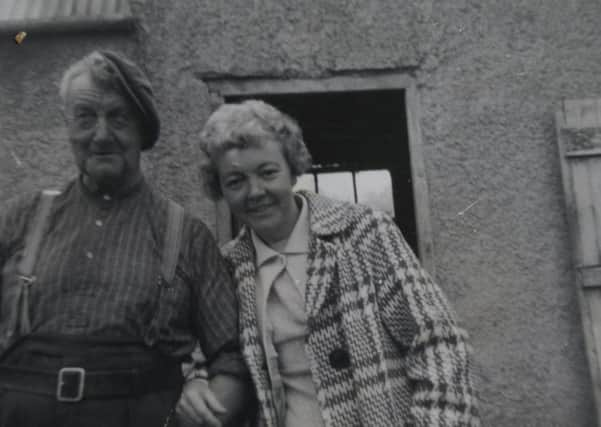Three generations of WWII evacuee's family return every year to remember


Roamer-regulars enjoyed her recollections of WWII when she was an evacuee from Belfast, in Letterkeen near Kesh.
She vividly described the little local school, and the home-cooked food that she enjoyed.
Advertisement
Hide AdAdvertisement
Hide AdParticularly hearth-griddled soda bread and potato scallops!
She told us of the crisp, white snow that bedecked the Lakeland’s drumlins in winter.
She relived sultry, summer evenings, meandering country lanes and chatting over farmyard gates.
The whole community welcomed Belfast’s evacuees to their town, safe from marauding German bombers. The city-folk joined in church and social life, attending the regular local dances, fairs and tea-parties.
Advertisement
Hide AdAdvertisement
Hide AdBut Renee’s evocative accounts from 1940 contained one of this page’s saddest ever stories.
Whilst most of her Fermanagh recollections were exceedingly warm and happy, they contrasted profoundly with her description of a grieving Belfast-man at Letterkeen’s railway-station.
The day after she arrived in the town Renee went back to the station to meet other members of her family circle who’d come on the next train.
She saw a man alight from a carriage, plainly very deeply distressed.
Advertisement
Hide AdAdvertisement
Hide AdHe too was an evacuee, the father of a family whose house received a direct hit from a German bomb.
The grief-stricken parent, with tears streaming down his face, was so overcome with sorrow that he couldn’t speak.
Sobbing helplessly he paced the platform, clasping a child’s shoe in his hand - all that was left of his happy Belfast family before the bomb rent it cruelly asunder. Never again would he be with his wife and children in their cosy, red-bricked, east Belfast home.
His only solace - a single, small, child’s shoe. Since Renee shared that heart-breaking story I’ve often wondered - who was that man and how did he fare? Renee recently returned to Letterkeen with her daughter, and wrote a short note outlining an infinitely different and much happier experience.
Advertisement
Hide AdAdvertisement
Hide AdShe began by reminding me that when her mother and her five brothers and sisters were evacuated “the gentleman who took us in had been a sergeant in the First World War.”
I checked back on one of Renee’s previous letters to Roamer when she introduced her family’s generous benefactor as “dear Johnston Armstrong of Letterkeen who put up with us city children for so long!”
As we’re all well aware, this year is the 100th anniversary of the Battle of the Somme, and many towns and villages around Northern Ireland marked the anniversary with special events and exhibitions.
When she was in Letterkeen a few weeks ago Renee and her daughter “popped in to view a display of WWI paraphernalia.”
Advertisement
Hide AdAdvertisement
Hide AdThe man in charge of the exhibition “was so informative” she explained “and the display was very interesting.”
Roamer has visited many wartime exhibitions around Northern Ireland this year, and while the major ones in our bigger towns and cities received most media attention, the numerous local displays and centenary anniversaries were intensely moving.
I was particularly gripped by a small display in the Gobbins Visitor Centre, near the breathtakingly-panoramic, cliff-side walkway on the coast of Islandmagee.
The Gobbins exhibition was entitled ‘Islandmagee Seamen in the Great War - 100 faces from 1918 to 1921.’
Advertisement
Hide AdAdvertisement
Hide AdThe captivating array of local seafarers’ photographs and biographies was compiled by historian David Snook, who maintains an excellent website about Irish seamen in the Great War.
(At www.irishmariners.ie - the website contains details of over 20,000 Irish-born merchant seamen and their voyages during WWI.)
Islandmagee’s ‘100 faces’ were displayed, side by side, one above the other, in a corridor - mostly old black and white, passport-style photographs, each one of a seafarer who served on an often endearingly-named merchant ship - the SS Buffalo, the SS White Head, the SS Donegal.
Many of the sailors were mere youngsters. Many never returned from their hazardous, wartime voyages. Sixteen-year-old Alexander Johnston was one of 14 lost in the Mediterranean Sea when his 5,000 ton, Belfast-built cargo ship SS War Clover was torpedoed by a U-Boat on October 19, 1917.
Advertisement
Hide AdAdvertisement
Hide AdTwenty-year-old James Macaulay Kane was one of 21 who died when the Belfast-owned 3,000-ton steamer SS Bray Head was torpedoed 375 miles from Fastnet on March 15, 1917.
David Snook’s exhibition, beside the coastline that beckoned Alexander and James to sail the seas, brought home the huge sacrifice of war, and the men from here, there and everywhere, to whom we owe such a great, unpayable debt.
A few weeks ago in Letterkeen Renee McAllister told the man in charge of the town’s WWI exhibition “it was a pity there weren’t any medals belonging to Johnston Armstrong.”
She remembers seeing them in his house when she was an evacuee. “Surprisingly, the man said that they were in ‘that little cabinet behind you’!”
Advertisement
Hide AdAdvertisement
Hide Ad“And they were!” exclaimed Renee in her letter - “one of them for bravery, and three others. I was so proud! I felt Johnston had done his bit in both wars and I felt he should have had another medal for taking in my mother and six children.”
Mr Armstrong’s kindness reaped a lasting reward, profoundly verified in Renee’s closing words - “ so that 76 years later myself, my children, grandchildren and great grandchildren still go every year on trips to Letterkeen!”